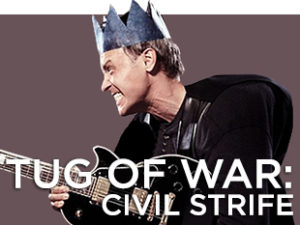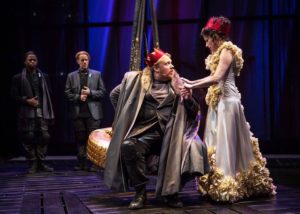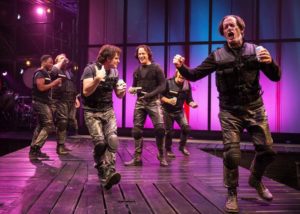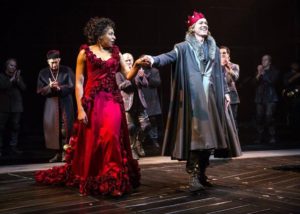
 Highly Recommended *****. Nearly ten months into the Shakespeare 400 Festival, the second half of Chicago Shakespeare Theater artistic director Barbara Gaines’s Tug of War series has arrived in high style. Followers of the Chicago theatre scene will recall that the first half of Tug of War, Foreign Fire, which played in May, focused on the Hundred Year’s War, and was a composite of three plays William Shakespeare wrote at very different points in his career (Edward III, Henry V, and Henry VI Part One). Civil Strife, now in a limited run only through October 9th, focuses on the Wars of the Roses, and is made up of three plays Shakespeare wrote as sequels to each other: Henry VI Parts 2 and 3, and Richard III. Though some narrative elements remain the same, the two parts of Tug of War are aesthetically different works, and while the second half is certainly a must-see for anyone who saw Foreign Fire, I know based on my companion’s reaction that a person can greatly enjoy Civil Strife on its own.
Highly Recommended *****. Nearly ten months into the Shakespeare 400 Festival, the second half of Chicago Shakespeare Theater artistic director Barbara Gaines’s Tug of War series has arrived in high style. Followers of the Chicago theatre scene will recall that the first half of Tug of War, Foreign Fire, which played in May, focused on the Hundred Year’s War, and was a composite of three plays William Shakespeare wrote at very different points in his career (Edward III, Henry V, and Henry VI Part One). Civil Strife, now in a limited run only through October 9th, focuses on the Wars of the Roses, and is made up of three plays Shakespeare wrote as sequels to each other: Henry VI Parts 2 and 3, and Richard III. Though some narrative elements remain the same, the two parts of Tug of War are aesthetically different works, and while the second half is certainly a must-see for anyone who saw Foreign Fire, I know based on my companion’s reaction that a person can greatly enjoy Civil Strife on its own.
That said, a person who saw Foreign Fire or who has other exposure to Henry VI Part One comes to Civil Strife with the advantage of already knowing who Henry VI (Steven Sutcliffe) and the scheming nobles surrounding him are. Henry is a gentle, peace-loving soul who was crowned king at nine months old, and his suffered for it ever since. The courtiers grew too powerful even as their domain over France disintegrated, and the Duke of Suffolk (John Tufts) arranged for Henry to enter with Margaret of Anjou (Karen Aldridge) into a political marriage that is worse than useless to Henry, but advantageous to Suffolk, whom Gaines imagines as Margaret’s lover. Their alliance pushes the Duke of York (a floppy-haired rock star Larry Yando) to press his claim to the throne, and in the famous garden scene which gives the Wars of the Roses their name, the other nobles choose sides between York and Margaret’s puppet, Henry.
Before the sides go to war, they have a common goal in removing Henry’s current steward. Once he’s dispatched through hypocritically tyrannical means, the blood starts flowing through a striking design concept by scenic designer Scott Davis and special effects studio Tolin FX. York symbolically injures himself and smears his blood across a massive glass wall. Bloody rains down on that same wall every time a character dies, which is quite often. And yet, when civil war finally does break out, it is introduced not by York, but by his ally, Jack Cade (Kevin Gudahl), whom Gaines depicts as Donald Trump, but behaves like Pol Pot. This pretender who vows to make his mouth England’s only parliament leads his forces on an anti-intellectual rampage in which he persecutes everyone with a formal education. His followers’ willful rejection of reason presages England’s nation-wide decline into madness for decades, though we know the nobles’ peace was tenuous to begin with.
The genius of this work is that, while Richard III is one of Shakespeare’s best-known plays, Henry VI Parts 2 and 3 are new to most people, yet contain most of the development for characters people are used to seeing spring to the stage fully formed late in their stories. The actions in Richard III are much weightier when we understand that Richard (Timothy Edward Kane), the youngest of York’s four sons, was not always a monster, and that he and Margaret had a very tangled history with atrocities on both sides long before he resolved himself to be a villain. In particular, Margaret’s treatment of York the elder is viciously cruel, and it is a testament to both Aldridge and Yando’s skills as actors that they make York’s defeat so pitiful, after he has been such a vain and destructive character for the first several hours of the play. Kane, of course, is brilliant as well, as a proud and aggressive fighter whose confrontational nature inadvertently led to his beloved father’s defeat, and whose relationship with his brothers slowly turned from deepest comradery to murderous hatred.
The unification of the three plays deepens other iconic moments of the conclusion as well. Early on, the villainous Cardinal Winchester (David Darlow) is haunted on his deathbed by horrific visions of his victims. While some onlookers self-righteously declare that such a bad death results from an evil life, Henry VI pleads for no-one to judge the cardinal, whom Henry himself was often betrayed and abused by. The moment demolishes any desire the audience might have had to hiss Richard when he is subjected to the same vision five hours later—most of the characters do terrible things to each other, and that those things are done mutually does not make them any less terrible. The propagandistic depiction of the Tudor dynasty is, therefore, all the more jarring, but it is at least set up by Henry Tudor (Daniel Kyri) receiving Henry VI’s blessing. In a show with eighteen excellent performers, Sutcliffe’s Henry VI is a particularly outstanding character, and Kane’s performance as Richard benefits greatly from Richard’s having to wrestle with his pangs of conscience for having killed the person even he recognized as the best of them all (though the most disastrous politician).
It goes without saying that watching Civil Strife is a lot like watching an entire miniseries at once, but Gaines’s design team make use of the unique possibilities of the stage, instead of simply doing a live TV show. Susan E. Mickey’s costumes and Melissa Veal’s wigs and make-up are less on the abstract or supernatural side this time around, which benefits a show that doesn’t leapfrog generations, as Foreign Fire did. But Lindsay Jones’s sound design, as well as the Pink and Leonard Cohen-heavy musical selections, mesh seamlessly with the characters who are all epic heroes in their own minds (it’s a wonder to watch the younger Richard lead the Yorks in a chorus of “Raise Your Glass”). The delightful golden throne/tire swing also makes a reappearance from Part One. It’s true that there is a lot of politicking in these plays, particularly Henry VI Part 2, but in Shakespeare’s histories, that’s quite appropriate. The full scope of the massive narrative is such a magnificent work of theatre that it’s well-worth taking the time to drink in the set-up.
At Chicago Shakespeare Theater at Navy Pier, 800 E Grand Ave, Chicago. Plays through October 9.
Performances are six hours long.
| Wed, Sep 28: | 11:00am |
| Fri, Sep 30: | 5:00pm |
| Sat, Oct 1: | 4:00pm |
| Sun, Oct 2: | 1:00pm |
| Wed, Oct 5: | 11:00am |
| Fri, Oct 7: | 5:00pm |
| Sat, Oct 8: | 4:00pm |
| Sun, Oct 9: | 1:00pm |
Tickets are available by calling 312-595-5600 or by visiting ChicagoShakes.com
To see what others are saying, visit TheatreinChicago.com, go to Review Round-Up, and click “Tug of War.”






More Stories
“Henry Johnson”
“Scary Town” reviewed by Frank Meccia
“Translations”